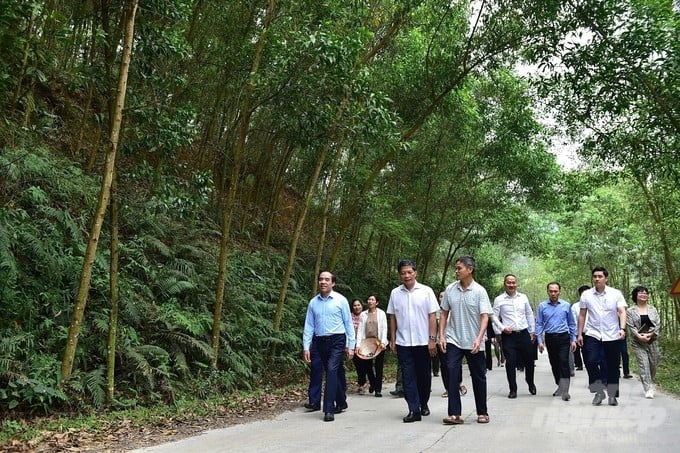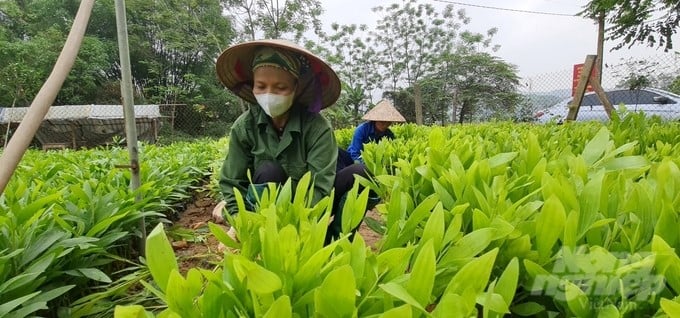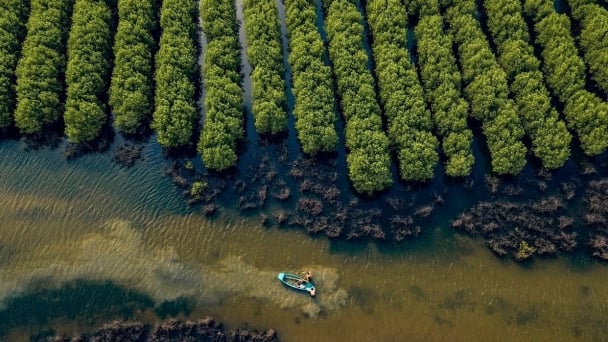June 15, 2025 | 04:23 GMT +7
June 15, 2025 | 04:23 GMT +7
Hotline: 0913.378.918
June 15, 2025 | 04:23 GMT +7
Hotline: 0913.378.918

Mr. Tran Tuan Anh, Politburo Member, Head of the Central Economic Commission, and leaders of Tuyen Quang province visited the model of afforestation in Tuyen Quang. Photo: Dao Thanh.
Deputy Director of Tuyen Quang Department of Agriculture and Rural Development Mai Thi Hoan said that Tuyen Quang has done well in protecting and developing forests and developing the forestry economy. As evidence of this, Tuyen Quang has become the third-largest locality in the country in terms of forest coverage (more than 65%). The total existing forest area is more than 422,400 ha, of which the forest area planted with timber for raw materials is over 140,700 ha.
Annually, the province exploits and freshly afforests more than 10,000 ha. The total output of wood exploited from planted forests is over 900,000 m3. The province has over 43,800 ha of forests certified for sustainable forest management. In the 2021–2025 period, Tuyen Quang strives to develop a large timber forest area of over 89,000 ha.
However, the development of forests for the forestry economy and large-timber forests still faces difficulties and barriers, especially in the implementation of guidelines, resolutions, laws, etc. Through an actual survey of Tuyen Quang’s Agriculture and Rural Development sector in Chiem Hoa and Ham Yen districts, when implementing large timber afforestation, there are still difficulties and problems, such as: The economy of most afforestation households is still at a disadvantage, so they need to exploit young forests with small-diameter wood to ensure their livelihood. In addition, planted forests with a long business cycle are prone to risks from pests, diseases, and natural disasters (wind, storms, etc.) that damage and degrade forest quality, so people have to exploit forests at a rapid growth stage.
Along with that, at present, the price of forest products is not stable; the price of large timber is not much different from the price of raw wood. Some forest owners have not invested in improving the quality of planted forests and have relied on the State's support policies, so the area of large timber afforestation and the area transformed from raw timber afforestation for paper production into large timber businesses in the district are not guaranteed to reach the target. Besides, due to the obstacles in the loan guarantee regulations when applying for loans at banks, the forest owners’ policy implementation in developing large timber forests is still limited.

To encourage large timber afforestation, Tuyen Quang province also supports high-quality seedlings for forest growers. Photo: Dao Thanh.
Another difficulty is that only a few wood processing and exporting factories need certified forests, while others do not, so it is difficult to keep large timber forests. Along with that, with households planting, exploiting, and selling young forests, the locality’s authorities could not have management sanctions but only mobilized and disseminated them, so it is difficult to keep large and perennial timber forests to improve the quality.
Meanwhile, in Vietnam today in general and in Tuyen Quang in particular, the forest growers’ thinking that FSC certificates are only needed for export and not for domestic consumption is also a barrier to large timber forest development. Because the price of certified forests for domestic sale is only equal or insignificantly higher compared to uncertified forests, in their mind, they will lose the money incurred for hiring an assessment expert if they do certification procedures.
Despite certain difficulties and barriers in the development of large-timber forests and FSC-certified forests, it is undeniable that the forestry economy has brought great achievements to Tuyen Quang province over the years. These are the results of guidelines and resolutions that are close to reality and the people’s needs and aspirations, helping people change their awareness and attachment to the forest.
Clear evidence includes: the export turnover of forest products of Tuyen Quang province in the 2017–2022 period reached USD 119 million; the GRDP of the province's forestry sector in 2022 reached over VND 1,750 billion, accounting for over 17% of the GRDP of agro-forestry-fishery; average growth reached over 10%/year; and the value of wood processing products accounted for 14% of the province’s industrial production value. Tuyen Quang forest is reaching out strongly, developing from special-use forests and primary forests to production forests. After 10 years, the households that stuck with the forest in the past are now well-off farmers. The forest led them to a prosperous life.

High-quality forests are a prerequisite for enterprises to produce and process wood for export. Photo: Dao Thanh.
Accompanying people to develop large-timber forests and high-quality forests, Tuyen Quang province has developed Resolution No. 36 of the Provincial Party Committee in 2021, setting goals for sustainable forestry development in the 2021–2030 period. The development goals must adhere to the guidelines, viewpoints, orientations, goals, and tasks of socioeconomic development in general.
Accordingly, the key tasks and solutions are to develop an agroforestry economy, exploit and use forest resources effectively and rationally, protect the environment, and adapt to climate change in particular. These have been identified in the Document of the 13th National Party Congress, the Document of the 17th Provincial Party Congress, and the Provincial Planning for the 2021–2030 period, with a vision to the year 2050.
Based on this Resolution, Tuyen Quang’s Agriculture and Rural Development sector advises the Provincial People's Council to issue Resolution No. 03 for the period 2021–2025. This Resolution also promulgates policies to support the transformation of small timber forests into large timber ones. The policies aim to support material areas for forest product processing factories, especially for export to demanding markets such as the US, Japan, and Europe. In which 50% of the loan interest rate is supported for organizations and individuals borrowing funds to transform small timber forests into large timber ones (extending the forest age to over 10 years). For each transformed forest area, organizations and individuals are supported with a loan interest rate once per unit of that area. The maximum level of loans with a supporting interest rate is VND 70 million/ha. The period of support for the interest rate is according to the loan period but must not exceed 36 months.
After more than two years of implementing this guideline, many localities have successfully expanded the area of large timber afforestation. The total area of large timber afforestation development in the whole province by the end of 2022 was 76,652/ 76,000 ha, reaching 100.8% of the plan. The Agriculture and Rural Development sector is coordinating with localities to carry out a statistical review of the area, support policies on seedlings, and preferential loan policies so that forest owners can feel secure in their long-term commitment to the process of participating in planting, protecting, expanding, and developing large timber afforestation.
Translated by Huyen Vu Thu
![Turning wind and rain into action: [4] Bringing climate bulletins to remote and isolated areas](https://t.ex-cdn.com/nongnghiepmoitruong.vn/608w/files/linhnhp/2025/06/14/1152-z6704423696987_15fd32ffc26d590d204d520c9dac6786-nongnghiep-151141.jpg)
(VAN) The Vietnam Agriculture and Nature Newspaper interviewed Mr. Vu Thai Truong, Acting Head of Climate Change and Environment at UNDP Vietnam, to gain deeper insight into how climate bulletins are delivered to farmers.

(VAN) In Tien Giang, a high-tech shrimp farm has developed a distinctive energy-saving farming model that has yielded promising results.
![Turning wind and rain into action: [3] 300.000 farmers benefit from agro-climatic bulletins](https://t.ex-cdn.com/nongnghiepmoitruong.vn/608w/files/news/2025/06/12/e5a48259d6a262fc3bb3-nongnghiep-125122.jpg)
(VAN) The agro-climatic bulletin has become a valuable tool for farmers in the Mekong Delta. After more than five years of implementation, the initiative is gradually being expanded nationwide.
![Turning wind and rain into action: [2] Providing forecasts to the people](https://t.ex-cdn.com/nongnghiepmoitruong.vn/608w/files/news/2025/06/12/e5a48259d6a262fc3bb3-nongnghiep-103927.jpg)
(VAN) In addition to improving the quality of hydrometeorological forecasts, putting forecast bulletins into practical use is crucial for production and disaster prevention.

(VAN) Blue carbon is receiving attention for its rapid absorption capacity and vast potential. It represents a promising nature-based solution to respond to climate change.
/2025/06/11/3507-1-161904_583.jpg)
(VAN) Seagrass beds and coral reefs serve as 'cradles' that nurture life in the ocean depths, creating rich aquatic resources in Vietnamese waters.
![Turning wind and rain into action: [1] Forecasting for farmers](https://t.ex-cdn.com/nongnghiepmoitruong.vn/608w/files/news/2025/06/11/e5a48259d6a262fc3bb3-nongnghiep-111919.jpg)
(VAN) Weather is no longer just a matter of fate. Forecasts have now become an essential companion for farmers in every crop season.